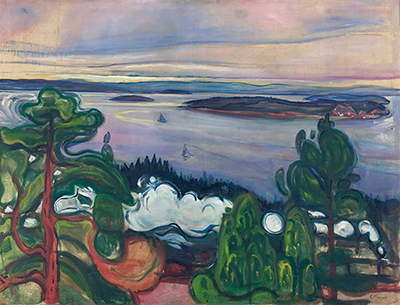Edvard Munch's painting entitled Train Smoke is an oil on canvas artwork which the artist produced in 1900. The work reflects the popular art noveau style which was particularly in demand at the turn of the century.
This was a productive time for the artist during a period in which he produced a number of landscape paintings for the new millennium. While the work is entitled Train Smoke, the majority of the canvas is dominated by images of large trees to the foreground with a lake, a number of islands and the sky featured in the middle and upper parts of the paining. The green leaves of the tree are portrayed in a 'stylized' curved manner showing them attached to a brown skeleton which depicts the tree trunks. The smoke is depicted in a number of connecting, white bubbles, emanating from the right of the canvas, which are clearly defined by the darker depiction of the surrounding forest of trees.
The source of the smoke mentioned in the title is almost lost within the painting as the artist seems to wish to convey the effect of the smoke from the steam engine as it spreads from the right to the left of the canvas. The train itself is almost indiscernible with its existence merely suggested beneath the column of smoke as it rises and spreads across the painting. Other paintings by Munch from this period and which feature views of this general area include: Sunset, two canvases which are both entitled, View from Nordsrtand, The Island and Winter at Nordstrand. These paintings are all to be found in private collections, with the exception of one of the View from Norstrand canvases which can be seen in the Kunsthalle Museum of Mannheim, Germany.
The scene for the painting is the Bunne Fjord, which is the inner most part of the Oslo Fjord. The area was the source of great inspiration for the artist as many of his other landscape works, created in the early part of the twentieth century, were set in this general area close to the Norwegian capital. Train Smoke can be seen at the Munch Museum (Munch-museet) in Oslo Norway. The painting was one of a large number of art works, more than 26,000, donated to the city of Oslo upon the death of the artist in 1944. The collection will relocate to a brand new museum on Oslo waterfront in early 2021.




